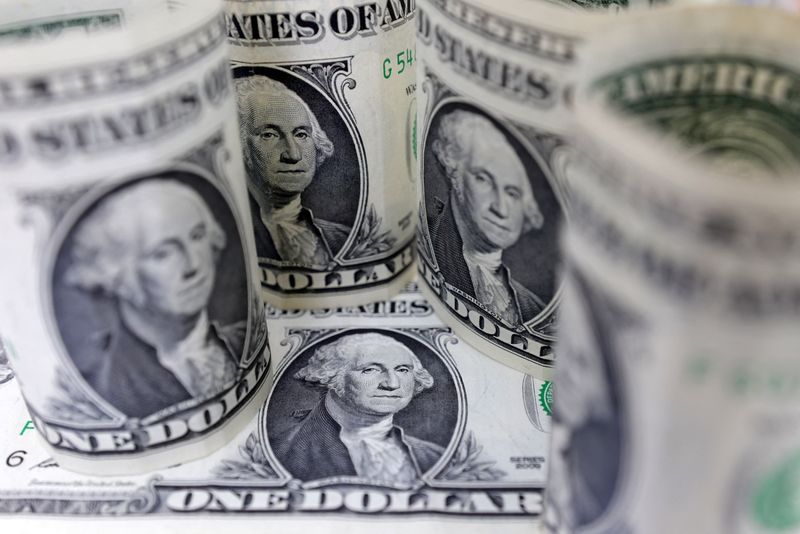Forex
Dollar slides after slowing U.S. jobs growth in July


© Reuters. FILE PHOTO: U.S. Dollar banknotes are seen in this illustration taken July 17, 2022. REUTERS/Dado Ruvic/Illustration
By Herbert Lash
NEW YORK (Reuters) – The dollar fell on Friday, paring almost all the week’s gains, after slowing U.S. jobs growth in July encouraged hopes of a soft economic landing but higher wages suggested the Federal Reserve may need to keep interest rates higher for longer.
The U.S. economy added fewer jobs than expected last month. However, solid wage gains and a drop in unemployment to 3.5% signaled continued tightness in the labor market.
Nonfarm payrolls increased by 187,000 jobs last month, the Labor Department’s survey of households showed, less than a Reuters’ survey of economists who forecast growth of 200,000.
Downward revisions in May and June job growth suggested demand for labor was slowing after the Fed’s hefty rate hikes. But with 1.6 job openings for every unemployed person, the moderation in hiring might indicate companies are failing to find workers.
The softer-than-expected jobs number halted this week’s surge in Treasury yields and stopped the dollar’s recent climb, said Marc Chandler, chief market strategist at Bannockburn Global Forex in New York.
“There’s a short squeeze in the foreign currencies, a bit of a long-dollar liquidation encouraged by a sharp drop in interest rates,” he said. “The dollar’s upside correction is almost over.”
Chandler said next week’s Consumer Price Index (CPI) report could show the first year-over-year rise in inflation since June 2022.
The market was positioned for a blowout number after a private payrolls report and still-low jobless claims data earlier this week, said Kathy Lien, managing editor of 60 Second Investor in New York.
“The case is still for a soft landing at worst,” Lien said. “But all of today’s data leaves the door open for another rate hike from the Federal Reserve.”
The , a measure of the U.S. currency against six peers, fell 0.4% after climbing on Thursday to 102.84, the highest since July 7. The decline was the dollar’s biggest single-day loss in three weeks.
The U.S. labor market is trending in the right direction, said Marvin Loh, senior global macro strategist at State Street (NYSE:) in Boston.
“Like a lot of the data we’ve gotten of late, there are things for the bulls and there are things for the bears,” he said.
Slowing jobs growth puts the economy closer to “that magical 100,000 to 120,000 (jobs) per month creation number” that Fed Chair Jerome Powell would like to see, Loh said.
But “wages picked up. We’re now running at 4.4% average hourly earnings year over year. That’s still inconsistent with the Fed’s 2% goal,” he said.
The euro gained 0.55% to $1.1004 and the Japanese yen strengthened 0.51% at 141.81 per dollar.
Long-term U.S. Treasury yields hit nine-month highs on Thursday, on the back of a deluge of supply as well as data pointing to further resilience in the labor market. [US/]
The yen has been sensitive to higher U.S. yields as the Bank of Japan keeps local rates pinned down. After the BoJ’s surprise monetary policy tweak last week, traders are trying to gauge how fast and how high it will let yields rise. [JP/]
The Australian dollar was buoyed – in addition to dollar weakness – by the end of Chinese anti-dumping and anti-subsidy tariffs on Australian barley imports as the trade partners repair strained ties. [AUD/]
The rose 0.18% versus the greenback to $0.656.
The Swiss franc, the G10 currency that has gained the most against the dollar this year, reversed declines after the jobs data. The dollar fell 0.11% against the franc.
Sterling was last trading at $1.2742, up 0.23% on the day.
Currency bid prices at 4:00 p.m. ET (2000 GMT)
Description RIC Last U.S. Close Pct Change YTD Pct High Bid Low Bid
Previous Change
Session
Dollar index 102.0200 102.4500 -0.40% -1.420% +102.6200 +101.7300
Euro/Dollar $1.1006 $1.0950 +0.52% +2.72% +$1.1042 +$1.0935
Dollar/Yen 141.8100 142.5200 -0.49% +8.17% +142.8750 +141.5500
Euro/Yen 156.07 156.04 +0.02% +11.24% +156.6300 +155.9100
Dollar/Swiss 0.8731 0.8742 -0.09% -5.54% +0.8782 +0.8700
Sterling/Dollar $1.2743 $1.2709 +0.26% +5.37% +$1.2792 +$1.2689
Dollar/Canadian 1.3384 1.3353 +0.25% -1.20% +1.3394 +1.3320
Aussie/Dollar $0.6566 $0.6549 +0.25% -3.68% +$0.6609 +$0.6542
Euro/Swiss 0.9608 0.9570 +0.40% -2.90% +0.9623 +0.9570
Euro/Sterling 0.8635 0.8613 +0.26% -2.36% +0.8647 +0.8602
NZ $0.6091 $0.6077 +0.21% -4.09% +$0.6133 +$0.6072
Dollar/Dollar
Dollar/Norway 10.1360 10.2440 -1.26% +3.07% +10.2380 +10.0850
Euro/Norway 11.1578 11.2221 -0.57% +6.33% +11.2469 +11.1264
Dollar/Sweden 10.5784 10.6988 -0.45% +1.63% +10.7203 +10.5370
Euro/Sweden 11.6424 11.6945 -0.45% +4.42% +11.7325 +11.6290

 Forex3 years ago
Forex3 years agoForex Today: the dollar is gaining strength amid gloomy sentiment at the start of the Fed’s week

 Forex3 years ago
Forex3 years agoUnbiased review of Pocket Option broker

 Forex3 years ago
Forex3 years agoDollar to pound sterling exchange rate today: Pound plummeted to its lowest since 1985

 Forex3 years ago
Forex3 years agoHow is the Australian dollar doing today?

 Cryptocurrency3 years ago
Cryptocurrency3 years agoWhat happened in the crypto market – current events today

 World3 years ago
World3 years agoWhy are modern video games an art form?

 Commodities3 years ago
Commodities3 years agoCopper continues to fall in price on expectations of lower demand in China

 Economy3 years ago
Economy3 years agoCrude oil tankers double in price due to EU anti-Russian sanctions























